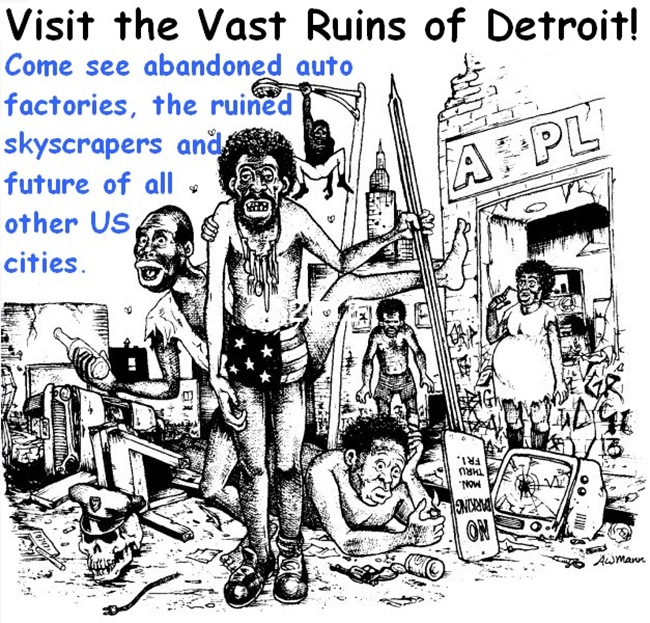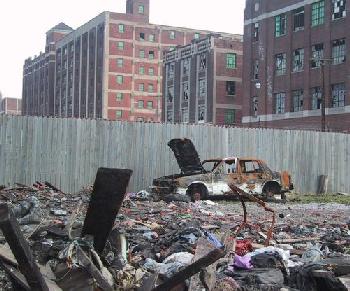Los Angeles Times
December 28, 2013

DETROIT — He’d heard stories of ruin and blight, but that didn’t prepare Oliver Kearney for what he saw:
Prostitutes roaming the streets at 8 a.m., rubble-strewn parking lots overrun with weeds, buildings taken over by bright pink graffiti, the message scrawled on blackboards in deserted schools: “I will not write in vacant buildings.”
He took 2,000 photographs his first day.
“No other American city has seen decline on this scale,” Kearney said. “It’s really a once-in-a-lifetime thing you’re going to see.”
And he saw it all on a tour.
Kearney, an 18-year-old aspiring architect, persuaded his father to travel with him from Britain to Detroit to participate in one of the city’s few burgeoning industries: tours of abandoned factories, churches and schools.
Led by tour guide Jesse Welter, they crawled on their hands and knees to peek inside a train station closed long ago; they squeezed through a gap in a fence to climb the stairs of what was once a luxury high-rise; they ducked under crumbling doorways to see a forgotten ballroom where the Who held its first U.S. concert.
“In Detroit, you can relate, you can see traces of what’s happened, you can really feel the history of a city,” Kearney said. “In Europe, when things become derelict, they’ll demolish them.”
That’s not possible here. The city estimates it has 78,000 vacant structures, and demolishing each derelict residential building costs $8,000 — money the bankrupt city can’t afford.
The city says that 85% of its 142.9 square miles had “experienced population decline” over the last decade, and efforts to persuade investors to buy commercial buildings and rehabilitate them have been mixed, at best. For example, plans to turn the Michigan Central Depot, a once-grand train station, into a casino and then into police headquarters have gone nowhere, and it’s stood empty since 1988.
Photographers have flocked to the city to capture the decline; two French photographers even produced a book, “The Ruins of Detroit.” But since the city declared bankruptcy in July, hotels say they’ve seen an uptick in visitors inquiring about the ruins. So have restaurants in the up-and-coming district of Corktown, near the abandoned train station.
Welter says he had to buy a 12-seat van to accommodate the growing interest.
Welter once worked as an aircraft mechanic and then an ATM repairman. He dabbled in photography and began venturing into the city from his home in the suburb of Royal Oak, taking pictures of derelict buildings and selling the shots at an artists market.
The photos, though grim, brought back sweet memories: Viewers would remember passing through the train station in its glory, or recall photographs of their grandparents honeymooning at a posh hotel, depicted in Welter’s photos as a decaying tower.
Welter, 42, figured that if other people were interested in seeing the buildings, he could guide them around and, perhaps more important, keep them safe. In October, two tourists were carjacked while visiting an abandoned factory; others have been assaulted there.
Welter guided his first tour in late 2011, but the business has really picked up this year. His clients pay $45 for a three-hour tour and explore some of Detroit’s most famously blighted structures: the Packard Automotive Plant, the train station and the East Grand Boulevard Methodist Church, which features peeling paint and vast balconies.
Welter, who is bearded and slim, knows how to sneak into buildings closed to the public. He knows which neighborhoods are plagued by packs of feral dogs, and which ramshackle building contains a recording studio with equipment still set up as if its occupants just left for lunch. He knows the churches so well that he helped a young couple find an abandoned one in which to conduct their wedding.
It’s not legal, per se, to enter these buildings. Police will give $225 tickets for trespassing if people enter schools, Welter says, but have otherwise told him they don’t mind him going into other buildings.
On a recent weekday morning, he brought a visitor to one of his favorite spots, St. Agnes Catholic Church, a rotting structure where graffiti vandals have made their mark. A beam of sunlight shone through the windows, falling on the one remaining pew in the church, a haunting image that illuminated the church’s destruction. Then Welter heard a motor idling outside and quickly ushered his guest toward the exit.
“Someone’s pulling up out there; let’s start walking this way,” he said, moving toward the crumbling staircase that leads to the church’s courtyard, which was littered with soda cans and food wrappers.
